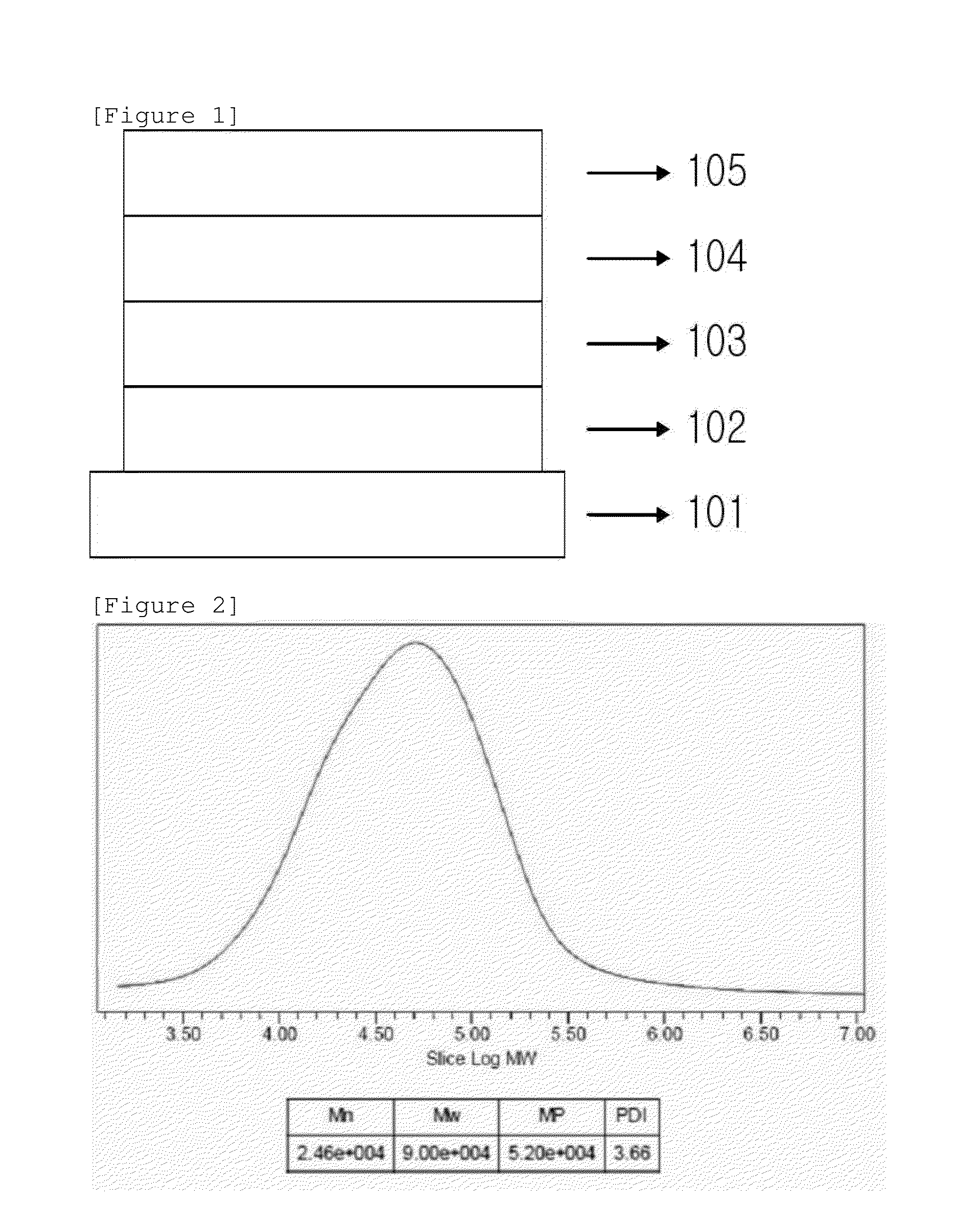Copolymer and organic solar cell comprising same
a solar cell and organic technology, applied in the field of organic solar cells and copolymers, can solve the problems of increased manufacturing costs, loss of electric charges, and annihilation of generated electrons and holes, and achieve the effects of increasing open-circuit voltage and short-circuit current, small band gap, and increasing efficiency
- Summary
- Abstract
- Description
- Claims
- Application Information
AI Technical Summary
Benefits of technology
Problems solved by technology
Method used
Image
Examples
example 1
Polymerization of Polymer (Polymerization of Copolymer 1)
[0219]
[0220]13 ml of chlorobenzene, 1.2 g (2.93 mmol) of 2,5-bis(trimethylstannyl)thiophene, 1.020 g (1.464 mmol) of 5,8-dibromo-2,3-bis(3-(octyloxy)phenyl)quinoxaline, 0.7018 g (1.464 mmol) of 1,3-dibromo-5-dodecylthieno[3,4-c]pyrrole-4,6-dione, 80 mg of Pd2(dba)3 (tris(dibenzylideneacetone)dipalladium(0)), and 106 mg of tri-(o-tolyl)phosphine were put into a microwave reactor vial, and reacted under the condition of 170° C. for 1 hour. After the mixture was cooled to room temperature and poured into methanol, the solid was filtered and subjected to Soxhlet extraction in methanol, acetone, hexane, and chloroform, and then the chloroform portion was again precipitated in methanol to filter the solid.
[0221]Yield: 46%
[0222]Number average molecular weight: 24,600 g / mol
[0223]Weight average molecular weight: 90,000 g / mol
[0224]FIG. 2 is a view illustrating a gel permeation chromatography (GPC) of Copolymer 1 prepared in Example 1.
example 2
Polymerization of Polymer (Polymerization of Copolymer 2)
[0225]
[0226]15 ml of chlorobenzene, 1.0 g (2.440 mmol) of 2,5-bis(trimethylstannyl)thiophene, 0.6716 g (1.220 mmol) of 4,7-dibromo-5,6-bis (octyloxy)benzo[c]-1,2,5-thiadiazole, 0.8500 g (1.220 mmol) of 5,8-dibromo-2,3-bis(3-(octyloxy)phenyl)quinoxaline, 67 mg of Pd2(dba)3 (tris(dibenzylideneacetone)dipalladium(0)), and 89 mg of tri-(o-tolyl)phosphine were put into a microwave reactor vial, and reacted under the condition of 170° C. for 1 hour. After the mixture was cooled to room temperature and poured into methanol, the solid was filtered and subjected to Soxhlet extraction in methanol, acetone, hexane, and chloroform, and then the chloroform portion was again precipitated in methanol to filter the solid.
[0227]Yield: 46%
[0228]Number average molecular weight: 18,800 g / mol
[0229]Weight average molecular weight: 40,100 g / mol
[0230]FIG. 3 is a view illustrating a gel permeation chromatography (GPC) of Copolymer 2 prepared in Exampl...
example 3
Polymerization of Polymer (Polymerization of Copolymer 3)
[0231]
[0232]15 ml of chlorobenzene, 0.9724 g (1.976 mmol) of 5,5′-bis(trimethylstannyl)-2,2′-bithiophene, 0.5440 g (0.988 mmol) of 4,7-dibromo-5,6-bis (octyloxy)benzo[c]-1,2,5-thiadiazole, 0.6885 g (0.988 mmol) of 5,8-dibromo-2,3-bis(3-(octyloxy)phenyl)quinoxaline, 54 mg of Pd2(dba)3 (tris(dibenzylideneacetone)dipalladium(0)), and 72 mg of tri-(o-tolyl)phosphine were put into a microwave reactor vial, and reacted under the condition of 170° C. for 1 hour. After the mixture was cooled to room temperature and poured into methanol, the solid was filtered and subjected to Soxhlet extraction in methanol, acetone, hexane, and chloroform, and then the chloroform portion was again precipitated in methanol to filter the solid.
[0233]Yield: 52%
[0234]Number average molecular weight: 25,700 g / mol
[0235]Weight average molecular weight: 120,000 g / mol
[0236]FIG. 4 is a view illustrating a gel permeation chromatography (GPC) of Copolymer 3 prepa...
PUM
| Property | Measurement | Unit |
|---|---|---|
| molecular weight distribution | aaaaa | aaaaa |
| molecular weight distribution | aaaaa | aaaaa |
| thickness | aaaaa | aaaaa |
Abstract
Description
Claims
Application Information
 Login to View More
Login to View More - R&D
- Intellectual Property
- Life Sciences
- Materials
- Tech Scout
- Unparalleled Data Quality
- Higher Quality Content
- 60% Fewer Hallucinations
Browse by: Latest US Patents, China's latest patents, Technical Efficacy Thesaurus, Application Domain, Technology Topic, Popular Technical Reports.
© 2025 PatSnap. All rights reserved.Legal|Privacy policy|Modern Slavery Act Transparency Statement|Sitemap|About US| Contact US: help@patsnap.com



